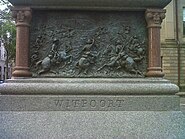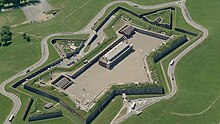 Boer War Monument, Province House | |
| Coordinates | 44°38′53.86″N 063°34′24.65″W / 44.6482944°N 63.5735139°WCoordinates: 44°38′53.86″N 063°34′24.65″W / 44.6482944°N 63.5735139°W |
|---|---|
| Location | Halifax, Nova Scotia, Canada |
| Designer | Hamilton MacCarthy |
| Type | War memorial |
| Opening date | 1901 |
| Dedicated to | Those who fought in the Boer War |
The South African War Memorial is a memorial located in the courtyard of Province House in Halifax, Nova Scotia, Canada
On October 19, 1901, the Prince of Wales (the future George V) laid the cornerstone for the monument. (This was the first visit to Canada by a Prince and Princess of Wales.) The Prince also gave medals to returning soldiers. Two weeks later, on November 1, the heroes of Paardeberg returned and marched triumphantly down George Street.
The statue was made by Hamilton MacCarthy (who also made the Boer War Monument in the Halifax Public Gardens and the Harold Lothrop Borden statue in Canning, Nova Scotia). At the base of the statue are four panels. One Panel is of the departure of troops from Halifax en route to South Africa; another is the Battle of Witpoort, which made Harold Lothrop Borden the most famous Canadian Casualty of the War; another depicts the Battle of Paardeberg (Canada's most significant battle of the war, with the most casualties); and the fourth panel is of the Siege of Mafeking. These panels were also meant to honour the three Canadian Services that fought in the war: the infantry, mounted rifles and artillery. The Nova Scotia Princess Louise Fusiliers and the Nova Scotia Highlanders participated in the war.
For two decades afterwards, Canadians would gather on February 27 (known in Canada as "Paardeberg Day") around memorials to the South African War to say prayers and honour veterans. This continued until the end of the First World War, when Armistice Day (later called Remembrance Day) began to observed on November 11.[1]
See also[]
External links[]
References[]
The original article can be found at South African War Memorial (Halifax) and the edit history here.




